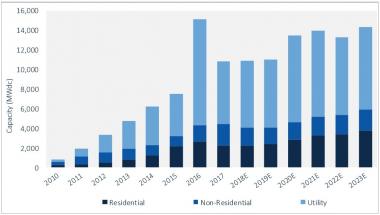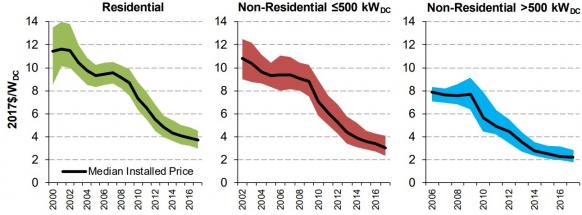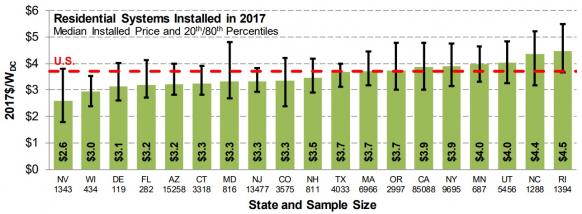US solar forecast rises after project activity hikes; Distributed PV prices flatten further
Our pick of the latest solar news you need to know.

Related Articles
GTM Research raises US solar outlook after 2018 procurement hike
GTM Research has raised its outlook for U.S. utility-scale solar installations in 2018-2023 by 1.9 GW after 8.5 GW of projects were announced in the first half of 2018.
U.S. developers installed 1.2 GW of utility scale PV in the second quarter of 2018, accounting for 55% of U.S. installed solar capacity, GTM Research said in its latest quarterly market report. A total of 2.7 GW of utility-scale projects are under construction and targeting completion in 2018, it said.
New project procurement hiked after the Trump administration implemented section 201 module tariffs in January, removing market uncertainty.
The forecast remains 7.9% lower than before the Trump administration indicated section 201 tariffs would be implemented, GTM Research noted.
"Many developers have reported that for a small portion of their pipeline, they are either still renegotiating PPAs [power purchase agreements] or have had to cancel projects entirely due to the addition of module tariffs," it said.
Forecast US solar installations
(Click image to enlarge)
Source: GTM Research, September 2018.
Utility-scale solar procurement will continue to grow over the next year as developers look to secure projects they can bring online before the Investment Tax Credit (ITC) steps down, GTM Research said. The ITC steps down from 30% for projects starting construction in 2019, to 10% from 2022 onwards.
Despite the phasing out of the ITC, the solar market should continue to grow as developers take advantage of the falling levelized cost of energy (LCOE) of solar technology, it said.
By 2023, the LCOE of a 20 MW utility-scale PV project will be lower than onshore wind projects in 49 state markets, according to analysis by GTM Research and Wood Mackenzie.
Wood Mackenzie recently acquired GTM Research and MAKE Consulting and has incorporated these companies into its new Wood Mackenzie Power & Renewables division.
US records slower average price drop for distributed solar
U.S. installed distributed solar prices are falling at a slower rate than in previous years, according to new study by the Lawrence Berkeley Laboratory (Berkeley Lab).
Last year, prices for large non-residential systems of capacity over 500 kW fell by 5% to $2.2/W and this year prices have been relatively unchanged, the report said.
For non-residential projects below 500 kW, prices fell by 11% in 2017 to $0.4/W and prices have fallen by only $0.1/W since the start of the year.
US distributed solar costs by sector
(Click image to enlarge)
Source: Berkeley Lab, September 2018.
The slowing rate of decline was primarily due to trends in module prices, but also reflected changes to installer share and business strategies, solar loan fees and diminishing opportunities for further cost savings, the Berkeley Lab said.
Prices also varied widely between states.
"Three of the largest state markets (California, Massachusetts, and New York) are relatively high-priced, pulling overall U.S. median prices upward. These cross-state pricing differences reflect both idiosyncratic features of particular states as well as more-fundamental differences related to market and policy conditions," the report said.
US distributed solar costs by state
(Click image to enlarge)
Source: Berkeley Lab, September 2018.
Con Edison buys 980 MW of Sempra's non-utility renewables
Consolidated Edison (Con Edison) is to buy Sempra Energy's 980 MW portfolio of U.S. non-utility operating solar assets, solar and battery storage development projects and a wind facility for a price of $1.5 billion in cash, Sempra said in a statement September 20.
Sempra announced it would sell the assets in June, as part of a multi-phase portfolio optimization which will include the sale of natural gas storage and infrastructure.
"Renewable energy is a vital part of the energy landscape and we have developed a great platform, but we have determined that our U.S. solar and wind generation businesses would be more valuable to another owner," Jeffrey Martin, CEO of Sempra Energy, said at the time.
"Our strategy is to continue building a leading energy company operating best-in-class utilities and developing contracted energy infrastructure in some of the largest economies in the Americas, with a focus centered on North America," Martin said.
The sale announcement followed a year-long strategic review and came amid pressure from activist investor Elliott Management Corp. and Bluescape Resources Co, which own a combined 4.9% stake in the company.
Con Edison is one of the U.S.' largest investor-owned energy suppliers with approximately $12 billion in annual revenues and $49 billion in assets.
UK industry could save 540 million pounds using small-scale renewables
UK industry could save some 540 million pounds ($708.1 million) in energy costs by switching to distributed energy sources such as solar power and battery storage, according to a new report by UK energy supplier Centrica.
UK industrial electricity prices are around 50% higher than the median price for IEA countries, excluding taxes. There are 16 sectors in the UK economy, including nine energy intensive industries, where energy costs represent more than 10% of total business expenditure.
A combination of small-scale power generation, demand-side response and energy efficiency measures could help businesses become more competitive in a post-Brexit world, the report said. Combined heat and power plants could also help lower costs, Centrica said.
"Helping businesses to use energy more effectively will be critical in ensuring that the UK can improve its productivity, boost competitiveness and seize new post-Brexit trade opportunities," it said.
New Energy Update



